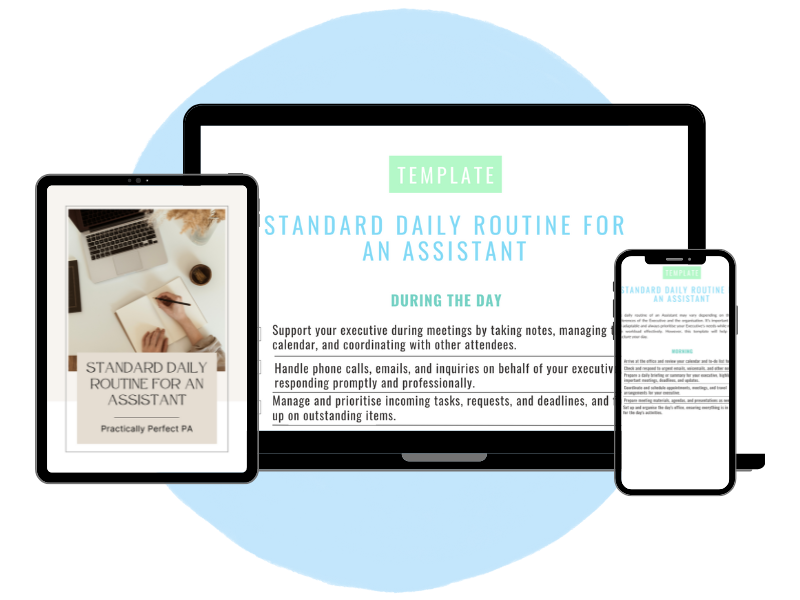Managing an Office Move: A Guide for Assistants
Office relocations can be daunting, especially when managing multiple moves, tight deadlines and high expectations from your Executive and colleagues. To navigate the complexities of relocating offices effectively, it’s essential to have a strategic plan in place. Here is Managing an Office Move: A Guide for Assistants, a comprehensive article tailored for Assistants to manage an office move efficiently.
Understanding Requirements
Assessing the needs of your organisation
Start by identifying the specific requirements of your office move. Consider the size of the new office, location preferences, accessibility, and the needs of different departments.
- Size of the New Office:
- Determine the square footage required.
- Account for current and future staffing levels.
- Ensure there is enough space for common areas, meeting rooms, and storage.
- Location Preferences:
- Proximity to public transportation.
- Availability of parking spaces.
- Nearby amenities such as cafes, gyms, and shops.
- Safety and security of the area.
- Accessibility:
- Ensure the building is compliant with disability access requirements.
- Evaluate the ease of access for deliveries and visitors.
- Consider the distance to other company locations if applicable.
- Departmental Needs:
-
- IT Department:
- Requirements for server rooms and IT infrastructure.
- High-speed internet and network setup.
- Sales and Marketing:
- Adequate meeting rooms and presentation areas.
- Collaborative spaces for brainstorming sessions.
- Finance and HR:
- Private offices or quiet areas for confidential work.
- Secure storage for sensitive documents.
- Client-Facing Teams:
- Welcoming reception area.
- Professional and comfortable meeting rooms.
- IT Department:
Budgeting
Creating a comprehensive budget is crucial for managing an office move effectively. In the Managing an Office Move: A Guide for Assistants is an example budget breakdown:
Example Budget for Office Move
| Category | Estimated Cost |
|---|---|
| Rent Deposit | $20,000 |
| Monthly Rent | $10,000 |
| Utilities | $2,000 |
| Renovations | $15,000 |
| New Furniture | $30,000 |
| IT Infrastructure | $25,000 |
| Moving Expenses | $10,000 |
| Contingency Fund | $10,000 |
| Total Estimated Cost | $122,000 |
- Rent Deposit: A typical deposit is usually one to three months’ rent upfront.
- Monthly Rent: Calculate the ongoing monthly rent for budgeting purposes.
- Utilities: Estimate costs for electricity, water, gas, and internet services.
- Renovations: Include costs for any necessary renovations to the new office space, such as painting, carpeting, and structural changes.
- New Furniture: Budget for desks, chairs, meeting tables, storage units, and any other necessary furniture.
- IT Infrastructure: Cover expenses for networking equipment, servers, telephones, and other IT-related needs.
- Moving Expenses: Include costs for professional movers, packing materials, and transportation.
- Contingency Fund: Allocate funds for unexpected expenses that may arise during the move.
Choosing the New Office
Getting the location right
When evaluating potential locations for your new office, it’s essential to consider a range of factors that will affect both day-to-day operations and employee satisfaction. In Managing an Office Move: A Guide for Assistants we want to share some key aspects to keep in mind:
Proximity to Public Transport
- Ensure the office is easily accessible via public transport, such as buses, trains, and subways. This is especially important in urban areas where many employees rely on public transit for their daily commute.
- A location near major transport hubs can make it easier for clients and visitors to reach your office, enhancing your company’s accessibility and professionalism.
Parking Availability
- For offices located in suburban or rural areas, ample parking space is crucial. Ensure there are enough parking spots for all employees, including provisions for guests.
- Evaluate the cost of parking facilities. Some locations might offer free parking, while others could require additional budgeting for leasing parking spaces.
Surrounding Amenities
- Proximity to cafes, restaurants, and food courts can significantly enhance employee satisfaction, offering convenient options for lunch and breaks.
- Consider nearby gyms, parks, and recreational facilities. These can promote a healthy work-life balance and increase employee morale.
- Access to banks, post offices, and retail shops can be beneficial for employees who need to run errands during their workday.
Safety and Security
- Research the safety of the area. A secure location can provide peace of mind for employees, especially those working late hours.
- Ensure the building has adequate security measures, such as surveillance cameras, security personnel, and controlled access points.
Centrality versus Car Parking:
- For city-centre locations, prioritize proximity to public transport and amenities over car parking. Urban offices should be within walking distance of major transit options to accommodate employees who commute by train or bus.
- In these areas, prioritize parking availability and easy access by car. Ensure there is sufficient space for all employees to park, and consider the distance from major highways or roads for convenient commutes.
Future Growth
- Choose a location that allows for future expansion. Evaluate whether there is potential to lease additional space in the building or if the surrounding area offers opportunities for growth.
- Consider the long-term plans for the area. Research any upcoming developments or changes in zoning laws that might affect your office location in the future.
Lease Negotiation
Negotiating a lease is a critical step in securing a new office space that meets your company’s needs. Here are the key components and strategies for effective lease negotiation:
Understand Your Needs
- Clearly define the amount of space you need, considering current staff and potential growth.
- Determine the ideal lease term for your company, balancing stability with flexibility.
- Set a budget for rent and associated costs, keeping in mind your overall relocation budget.
Research Market Rates
- Investigate rental rates for similar properties in the area to ensure you’re getting a fair deal.
- Stay informed about market trends and vacancy rates, which can give you leverage in negotiations.
Engage a Real Estate Agent
- Work with a real estate agent who specializes in commercial properties. Their expertise can help you navigate the complexities of lease agreements.
- A good agent will represent your interests, negotiating on your behalf to secure the best terms possible.
Key Lease Terms to Negotiate
- Base Rent:
- Aim for the lowest possible base rent. Use market research to justify your offer.
- Consider negotiating a lower initial rent with gradual increases over the lease term.
- Lease Term:
- Negotiate a term that aligns with your company’s plans. Shorter leases offer flexibility, while longer terms can provide stability and potentially lower rates.
- Include renewal options to extend the lease under predefined terms.
- Rent Escalation:
- Understand how rent increases will be calculated (e.g., fixed percentage, tied to inflation, or market rates).
- Negotiate caps on annual increases to avoid unexpected cost spikes.
- Tenant Improvements (TIs):
- Secure an allowance for tenant improvements to customize the space to your needs. Landlords often provide a TI budget to cover these costs.
- Ensure the TI allowance covers necessary renovations, such as office build-outs, painting, and carpeting.
- Operating Expenses:
- Clarify which operating expenses (e.g., utilities, maintenance, property taxes) are included in the rent and which are additional.
- Negotiate caps on increases in operating expenses and seek transparency in how these costs are calculated.
- Expansion Rights:
- Include provisions for potential expansion within the building or complex. This could involve first rights of refusal on adjacent spaces.
- Negotiate terms that allow you to take on additional space at a pre-agreed rate.
- Early Termination:
- Negotiate a clause allowing for the lease’s early termination under specific conditions, such as business downsizing or relocation.
- Discuss any associated fees or penalties for early termination to ensure they are manageable.
- Subleasing and Assignment:
- Ensure the lease allows you to sublease the space or assign the lease to another tenant if necessary.
- Clarify any conditions or landlord approvals required for subleasing.
- Maintenance and Repairs:
- Define the responsibilities for maintenance and repairs. Landlords typically handle structural repairs, while tenants cover interior maintenance.
- Negotiate for the landlord to maintain key building systems, such as HVAC, plumbing, and electrical.
- Review and Legal Counsel:
- Carefully review the lease agreement with your real estate agent to ensure all negotiated terms are accurately reflected.
- Consult with a legal professional who specializes in commercial real estate to review the lease for any potential pitfalls and to ensure it complies with local laws and regulations.
- Finalizing the Agreement:
- Approach negotiations with a clear strategy, prioritizing your must-haves while being prepared to compromise on less critical issues.
- Maintain open and clear communication with the landlord or their representative throughout the process to build a positive relationship.
- Once all terms are agreed upon and reviewed, finalize the lease agreement with all necessary signatures and ensure you receive a copy for your records.
Designing the Space
Layout Planning
Creating an effective office layout is a crucial step in ensuring the new space promotes productivity, collaboration, and employee satisfaction. Collaborate closely with designers to craft a layout that optimises space, ensures proper workflow, and caters to the diverse needs of various teams.
As we said earlier in Managing an Office Move: A Guide for Assistants it’s important for you to start by understanding the specific requirements of each department.
For instance, the IT department may need a dedicated server room with robust cooling systems and ample power outlets, while the sales and marketing teams might benefit from open-plan areas that facilitate easy communication and brainstorming sessions. The finance and HR departments often require quieter, more private spaces to handle confidential information.
Once you have a clear understanding of each department’s needs, work with designers to integrate these requirements into a cohesive layout.
Prioritise flexible spaces that can adapt to changing business needs. This could include modular furniture that can be reconfigured as teams grow or shift focus, and multi-purpose rooms that can serve as meeting areas, training rooms, or breakout spaces.
Consider the flow of movement within the office. Ensure that high-traffic areas, such as entrances, exits, and pathways to common areas like kitchens and restrooms, are wide enough to prevent congestion. Position collaborative spaces and meeting rooms centrally to encourage spontaneous interactions and cross-departmental collaboration, while placing more focused, quiet areas at the periphery to minimize distractions.
Incorporate ergonomic principles into the design to promote employee well-being. This includes selecting adjustable chairs and desks, ensuring adequate lighting, and providing options for standing desks. Natural light is also a key factor; position workstations near windows where possible to enhance mood and productivity.
Aesthetics play a significant role in creating an inviting and motivating work environment. Choose a color scheme and decor that reflect your company’s brand and culture. Incorporate elements such as greenery and art to make the space more vibrant and engaging.
Additionally, plan for future growth by designing with scalability in mind. Ensure that the infrastructure can support additional workstations and equipment as your company expands. This might involve installing extra power outlets, choosing a layout that can accommodate more desks without extensive reconfiguration, and considering the potential need for additional storage solutions.
Regularly review the layout with the design team and key stakeholders to ensure it meets all operational and aesthetic goals. Solicit feedback from employees to identify any potential issues or improvements before finalising the design. By thoughtfully planning the layout in collaboration with designers, you can create a functional, flexible, and attractive office space that supports your team’s productivity and well-being.
TOP TIP: Choose furniture that is functional, comfortable, and suits the office’s aesthetic. Prioritise quick delivery timelines to avoid delays.
Managing Stakeholders
Managing stakeholders is often the trickiest part of an office move. People tend to get deeply involved, each with their own opinions and preferences, which can elevate the expectations placed on you.
From executives with specific requirements to employees concerned about their daily commute, everyone has a stake in the new office. So, how do you handle it? The key lies in effective communication, strategic decision-making, and balancing all of the different interests to ensure a smooth transition that satisfies the majority.
In Managing an Office Move: A Guide for Assistants. here’s how we suggest you navigate the complexities of stakeholder management during an office relocation.
Communication
Centralised Communication
Keep the number of people involved in decision-making to a minimum to avoid confusion and delays. Typically, the core team should include yourself, an IT representative, and a member of the management team.
Keep the team informed about progress, deadlines, and any changes to the plan. Transparency helps manage expectations and reduces anxiety.
Handling Opinions
Collect Input Strategically
Everyone will have an opinion at some point during an office move. While it’s essential to consider people’s preferences, you can’t please everyone and shouldn’t waste your energy trying to. Gather input through surveys or meetings, but make final decisions based on practical considerations, all of the data and analysis that has gone into the project to date, and the overall benefits of the organisation and the majority of the employees.
Make swift decisions on matters like office location, layout, and furniture. Prolonged debates can stall the entire process.
Coordination and Execution
Timeline Management
Detailed Timeline
Developing a detailed timeline is crucial for ensuring a smooth and efficient office move. Here are the key milestones that need to be hit:
Initial Planning and Research:
- Identify office space requirements and budget.
- Research potential office locations and shortlist options.
Lease Negotiation and Signing:
- Finalise the selection of the new office space.
- Negotiate lease terms and conditions.
- Sign the lease agreement.
Design and Layout Planning:
- Collaborate with designers to create an optimal office layout.
- Approve final design plans.
Renovations and Fit-Outs:
- Schedule and commence any necessary renovations.
- Install infrastructure, such as cabling, lighting, and HVAC systems.
- Paint, carpet, and complete any other finishing touches.
Furniture and Equipment Orders:
- Finalise furniture selection and place orders.
- Order IT equipment and other necessary office supplies.
Utility Setup and IT Infrastructure:
- Arrange for the setup of utilities (electricity, water, internet, etc.).
- Install and test IT infrastructure, including servers, networking, and telephony.
Staff Communication and Involvement:
- Communicate the move plan and timeline to all employees.
- Organise staff meetings to address any concerns or questions.
- Assign packing responsibilities and provide packing materials.
Packing and Preparation:
- Pack non-essential items and archive old documents.
- Label boxes and items to ensure organized unpacking.
Moving Day Coordination:
- Hire professional movers and schedule the moving date.
- Supervise the packing, transportation, and unloading of office items.
- Set up workstations and common areas in the new office.
Post-Move Setup:
- Unpack and arrange items in the new office.
- Test all IT and communication systems to ensure they are operational.
- Conduct a walkthrough to address any immediate issues.
Final Touches and Settling In:
- Complete any remaining setup tasks, such as hanging artwork or installing additional furniture.
- Distribute welcome kits and provide an orientation for employees in the new space.
- Gather feedback from staff to address any concerns and make necessary adjustments.
Factor in lead times for internet setup, furniture delivery, and other critical services. For instance, internet installation might require a nine-week lead time.
Delegation and Dictation
Defining clear roles and responsibilities is essential for a successful office move project. For IT-related decisions, involve the CTO or IT head to ensure technical requirements are met. For all other decisions, maintain control yourself or with your office move team to streamline the process.
While delegating tasks where appropriate can help manage the workload, it’s crucial to retain oversight of critical aspects to avoid miscommunication and errors.
This is such a good project for Assistants to really lean into, as you are exposed to so many areas that will help you improve your overall skillset – delegation, decsion-making, complex project management and exposure to the entire organisation. By striking a balance between delegation and decision-making, you can ensure that all elements of the move are handled efficiently and effectively.
Dealing with Unforeseen Challenges
No matter how meticulously you plan, unexpected challenges are bound to arise during an office move.
From last-minute construction delays to unforeseen logistical hiccups, these surprises can throw a wrench in even the best-laid plans. How you handle these curveballs will significantly impact the overall success of the move.
The key is to remain flexible, think on your feet, and have contingency plans in place. Here’s how to effectively navigate and manage the unexpected obstacles that come your way during an office relocation.
Flexibility and Adaptability
- Anticipate potential issues such as furniture delivery delays, internet setup problems, or unexpected structural challenges, such as concrete floors that restrict cabling options.
- Be prepared to make quick decisions to resolve issues as they arise. For example, if a boardroom table arrives scratched, negotiate a replacement timeline or consider reordering in smaller parts.
Attention to Detail
- Ensure every detail is checked and double-checked, from floor plan accuracy to equipment set up correctly.
- Conduct final walkthroughs of the new office before moving in to ensure everything is as planned.
Making the Transition Smooth
Moving Day Coordination
Packing and Logistics
Coordinate with moving companies to ensure all items are packed, transported, and unpacked efficiently. Assign responsibilities for each area to ensure nothing is overlooked.
Desk Preparation
Ensure employees pack their desks ahead of time, especially those who might be away on moving day.
Example Communication for Desk Preparation
Subject: Important: Desk Packing Instructions for Upcoming Office Move
Dear Team,
As we approach our moving day, I wanted to provide some important instructions regarding the packing of your desks to ensure a smooth and efficient transition to our new office.
Desk Packing Instructions:
- Pack Ahead of Time: Please begin packing your desk items as soon as possible. All personal and work-related items should be packed and labeled by [specific date], especially if you will be away on the moving day.
- Label Your Boxes: Clearly label each box with your name and department. This will help our moving team place your belongings at your new workstation accurately.
- Secure Fragile Items: Make sure to wrap any fragile items, such as glassware, picture frames, or electronics, in bubble wrap or packing paper to prevent damage during the move.
- Remove Valuables: Do not leave any valuables or sensitive documents in your desk drawers. Take these items home or place them in secure storage until we are settled in the new office.
- Clean Out Drawers: Empty out all desk drawers, filing cabinets, and personal storage spaces. Use the provided packing materials to organize and pack your belongings.
- Office Supplies: Common office supplies and shared equipment will be packed and moved separately by the designated team. You only need to focus on your personal and work-related items.
- Notify if Assistance is Needed: If you require assistance with packing or have any specific concerns, please let me know by [specific date] so we can make the necessary arrangements.
Key Dates to Remember:
- Packing Completion Deadline: [specific date]
- Moving Day: [specific date]
- Unpacking at New Office: [specific date]
Your cooperation and prompt action are essential in making this move as seamless as possible. If you have any questions or need additional packing materials, please do not hesitate to reach out.
Thank you for your attention to this important matter and for your continued support as we prepare for this exciting transition.
Settling In
Welcome Kit
Prepare a welcome kit for employees in the new office, including maps of the new layout, local amenities, and any new procedures.
Feedback Loop
After the move, gather feedback to address any immediate issues and ensure everyone is comfortable in the new space. Make sure you also get some feedback on how you did as a project lead – it is so important that you are recognised for your accomplishments.
Conclusion
Managing an office move is no small feat, but with careful planning and a pinch of strategic thinking, you can ensure a smooth transition for your company.
Remember, in this Managing an Office Move: A Guide for Assistants, we’ve said to keep the lines of communication open, make decisions swiftly, and always have a contingency plan up your sleeve.
The key to a successful move lies in meticulous planning, clear communication, and the ability to adapt to unexpected challenges.




